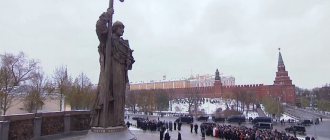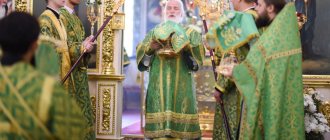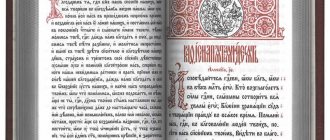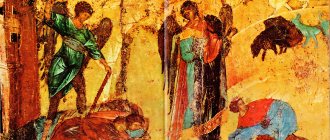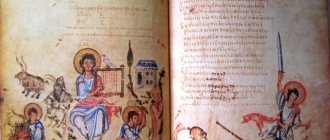| Source: | |
| Kaddish (aram. קַדִּישׁ - “holy”) is a prayer glorifying the holiness of the name of God and His power, and expressing the desire for final redemption and salvation. The Kaddish is composed in Aramaic, the language spoken by most of the Jewish people since the Second Temple era (only certain words and the final phrase are in Hebrew). It is noteworthy that in the text of this prayer there is no direct appeal to God, and His name is replaced by the pronoun “He” or epithets.[1] |
Historical review
The term kaddish first appears in the Mishnah.[2] Kaddish was originally said after the reading of the Torah and also at the end of a sermon,[3] the form of which appears to have had a significant influence on the style of the kaddish and on its everyday Aramaic language. The so-called “Rabbinical Kaddish” (“ Kaddish derabanan”
") are read on similar occasions even today. At the same time, already during the period of the Mishnah, kaddish became an essential part of synagogue worship.[4]
This prayer is read only in the presence of a minyan (ten adult men), standing and facing towards Jerusalem.[5]
The texts of Kaddish were already something generally known in the 12th century. Maimonides cites (Yad, Seder tefilot, Nusach ha-Kadish), interrupting them with the words “and so on.” The earliest editions of the Kaddish include its texts in the prayer book of Rabbi Amram Gaon (9th century), preserved in copies of the 14th century. - the beginning of the 16th century, in which the texts of the kaddish do not coincide verbatim, but in general correspond to those accepted today.
In the 13th–14th centuries. attempts to recite Kaddish in Hebrew were rejected by Shlomo Adret (“Sheelot u-teshuvot ha-Rashba” - “Responses of Rashba”, part 5, paragraph 54) and Yaakov ben Asher (Tur. OH. 56).
In Reform communities, the Kaddish, unlike many parts of the liturgy, is recited in the original language. The text of the morning Saturday prayer of the Karaites includes, as an optional reading, a rudimentary kaddish formula in Hebrew of ten synonyms for blessing and exaltation (the first two are from the opening phrase of the ordinary kaddish) with the conclusion: “The highly venerable and awesome name of God forever and ever.”
Haggadic literature repeatedly emphasizes the great importance of glorifying the holiness of God's name in kaddish. Thus, to the words of Rabbi Shimon ben Gamliel II: “Since the destruction of the Temple there has not been a day without a curse” (Sotah 9:12), Rava adds: “The world is maintained only thanks to the words 'blessed be His great name always and forever.' which are usually recited after studying a passage from the Haggadah” (Sotah 49a). And the Tanna of Joseph ben Khalafta (mid-2nd century AD) states that when the children of Israel exclaim: “Blessed be His great name...”, the Lord nods his head and says: “Blessed is the king to whom such praise is given” ( Br. For). According to the medieval Haggadah, the kaddish is pronounced in Aramaic, so that the archangels, who do not understand it, would not envy the people who expressed such majestic praise to the Lord (Tosafot to Brez. Za; cf. Shab. 12b).
The fact that the Kaddish was recited in a chant was written already in the second half of the 14th century. or early 15th century. Yaakov ben Moshe Molin. In the synagogue melos of Ashkenazi communities, kaddish melodies are very diverse - from recitative chant (for everyday life) to complex and impressive compositions for a solo cantor and choir (for holidays). The melodies of the kaddish before the Amidah on holidays generally correspond to the traditional tunes of her initial benediction. The melodies of the Kaddish before Musaf Rosh Hashanah and Yom Kippur, as well as the Kaddish before Neilah, are particularly rich in musical ornamentation.
Salomone dei Rossi wrote a kaddish for three and five voices. S. Sulzer was the first to compose melodies for response amen and “Blessed be His great name...” Arrangements of traditional kaddish melodies in a modern style were made by M. Ravel (“Two Jewish melodies” for voice and piano, 1914; one of them is kaddish), A. Crane (cantata “Kaddish”, 1922), L. Bernstein (Symphony No. 3 “Kaddish” for reader, choir and orchestra, 1957; oratorio of the same name, 1963). The literary theme of Bernstein's oratorio is consonant with the folklore kaddish associated with the name of Rabbi Levi, Isaac of Berdichev, who enters into an argument with the Lord and reproaches Him for the sorrows that befell the chosen people. As the funeral prayer is called kaddish in their works G. Heine and A. Galich.
Sephardic pronunciation of Kaddish Yatom
118.7 Kb |
01:00 YITGADAL VEITKADASH SHMEI RABA:
BEALMA DI VRA HIRIUTEY VEYAMLICH MALKHUTEY VEYATSMAH PURKANEY VIKAREV MESHIHEI:
BEHAYEIKHON UVEYOMEYKHON UVEHAYEY DEKHOL BEIT YISRAEL BAAGALAH UVIZMAN KARIV WEIMRU AMEN:
YEEY SHMEI RABA MEVORACH LEOLAM ULEOLMEI OLMAYA. YITBAREKH VEYISHTABAKH VEYITPAER VEIITROMAM VEYITNASE VEYITADAR VEYIT'ALE VEITGALAL SHMEY DEKUDSHA BRIH U:
LEEILA MIN KOL BIRKHATA VESHIRATA TUSHBEKHATA VENEHEMATA DAAMIRAN BEALMA VEIMRU AMEN:
YEE SHLAMA RABA MIN SHMAYAH VECHAYIM TOVIM ALEINU VEAL KOL YISRAEL VEIMRU AMEN:
OSE SHALOM BIMROMAV U YAASE SHALOM ALEINU VEAL KOL YISRAEL VEIMRU AMEN:
Content
The main text of the Kaddish consists of five phrases and is divided into seven passages by the proclamation “Amen”. Following the introduction (“ May His great name be magnified and sanctified”
": Wed.
Ezek.38:23) follows an expression of hope that the Most High “ will reveal His kingdom during your [those who pray] life... and in the near future
.”
The central part of the Kaddish is considered to be a paraphrase of the biblical text (cf. Ps. 113:2, Job 1:21, Dan. 2:20): “ Blessed be His great name always and forever
,” which is pronounced in chorus by all those praying, and the one who reads Kaddish repeats.
This is followed by a poetic, expressed in seven synonyms (symbol of the seven heavens in the Haggadah[6]) blessing and praise of the name of God, which is “ above all praises
,” and a request for the sending of peace and life to those who pray and to all Israel, again expressed in the conclusion (“
Creating Peace in His heights may He create peace for us and for all Israel
”: cf. Job 25:2).
In the Sephardic ritual, in the second passage, the words “ he will reveal His kingdom
” are supplemented by a request for speedy deliverance and the coming of Moshiach, and in the ritual of the Eastern communities, the penultimate phrase includes a list of a number of benefits requested in addition to peace and life.[1]
The main motifs of Kaddish are included in the Christian prayer Our Father (Matt. 6:9–10); they are also contained, however, in the Jewish thanksgiving on the occasion of rain after a drought (TI., Taan. 1:3, 64b).
Sephardic pronunciation of "Kaddish derabanan"
141.3 Kb |
01:12 YITGADAL VEITKADASH SHMEI RABA:
BEALMA DI VRA HIRIUTEY VEYAMLICH MALKHUTEY VEYATSMAH PURKANEY VIKAREV MESHIHEI:
BEHAYEIKHON UVEYOMEYKHON UVEHAYEY DEKHOL BEIT YISRAEL BAAGALAH UVIZMAN KARIV WEIMRU AMEN:
YEEY SHMEI RABA MEVORACH LEOLAM ULEOLMEI OLMAYA. YITBAREKH VEYISHTABAKH VEYITPAER VEIITROMAM VEYITNASE VEYITADAR VEYIT'ALE VEITGALAL SHMEY DEKUDSHA BRIH U:
LEEILA MIN KOL BIRKHATA VESHIRATA TUSHBEKHATA VENEHEMATA DAAMIRAN BEALMA VEIMRU AMEN:
AL YISRAEL VEAL RABANAN, VEAL TALMIDEYON VEAL KOL TALMIDEYON TALMIDEYON, VEAL KOL MAN DEASKIN BEORAYTA, DI VEATRA ADEN VEDI VECHOL ATAR VAATAR, YEE LEON ULECHON SHLAMA RABA HINA VEHISDA VERAHAMIN VEH AYIN ARIKHIN UMEZON REVIKHA UFURKANA MIN KADAM AVUGON DEVISHMAYA, VEIMRU AMEN:
YEE SHLAMA RABA MIN SHMAYAH VECHAYIM TOVIM ALEINU VEAL KOL YISRAEL VEIMRU AMEN:
OSE SHALOM BIMROMAV U YAASE SHALOM ALEINU VEAL KOL YISRAEL VEIMRU AMEN:
Types of Kaddish
There are four forms of kaddish:[1]
- half-kaddish
(
hatzi kaddish
; the first three phrases of the text) concludes the reading of the Torah, serves as the introduction or conclusion of some sections of the liturgy and is pronounced only by the leader of the service;
- The funeral kaddish
(
kaddish yatom
) consists of the five phrases mentioned above, is included in all prayers and is recited for a close relative for 11 months after his death and on the yohrzeit (anniversary of death).
This Kaddish was originally recited by the cantor to the relatives of the deceased during the seven days of mourning.[7] The recitation of funeral kaddish by close relatives was apparently established in the 13th century. in Germany after frequent cases of Jewish martyrdom during the Crusades. The funeral kaddish, which does not contain words about the afterlife or the resurrection from the dead, seems to serve as recognition of the justice of the heavenly court in the spirit of the Talmudic instruction: “ A person is obliged to give thanks for the evil that has befallen him, as for the good sent down to him
” [8];
- the full
or
public kaddish
(
kaddish shalem
, or
kaddish de-tzibbura
), is said by the leader of the service either after repeating the Amidah aloud or after reciting some additional prayers.
Its function is expressed in the prayer: “ Let the prayers and requests of all the house of Israel be accepted by their Father who is in heaven, and shout: Amen!
";
The first three forms of kaddish are already found in the prayer book of Rabbi Amram Gaon. There is also another kaddish, not recited today, called kaddish ha-yachid (“individual kaddish”). Its text consists of separate biblical verses and passages from the Haggadah, and apparently no minyan was required to read it.
- The Kaddish for the Welfare of the Scholars
(
Kaddish de-Rabbanan
) is recited twice in Shacharit after the halakhic and aggadic passages by those who say the funeral kaddish, and after studying such texts together by all those present.
In this kaddish, an addition to the central part of the text contains a prayer for the sending of " great peace to Israel, to the teachers of the Law, to their disciples ... and to all who study the Torah
." In the Middle Ages, this kaddish also included a request for the well-being of the heads of communities (nasi), the exilarch, the heads of yeshivas, and in the Yemenite ritual also Maimonides.
- The Kaddish read in the cemetery during the funeral
differs only by the insertion of a phrase about the coming of the Moshiach and the hope for the resurrection of the dead
In it, the introduction is expanded with words of hope for the renewal of the world, the resurrection from the dead, the restoration of the Temple and Jerusalem, for the salvation of the living and delivering them from sword and famine, for the eradication of the service of other deities in the world and for the fact that the Lord will “return sacred service to its place.” heavenly and His radiance, glory and presence, during your life and in your days and during the life of the whole house of Israel...” This introduction formula and the subsequent text of Kaddish de-Rabbanan form the so-called Kaddish Ha-Siyum, which is read at the end of the joint study of an entire Talmudic treatise . Its text is cited by Maimonides (see above) as being read after studying Halacha and Haggadah in a minyan.
Mourners' Kaddish (Kaddish Yatom)
Three times a day during daily prayers in the synagogue, the son is obliged to recite the funeral Kaddish (“Kaddish Yatom”) for eleven months after the death of his father or mother, and then on the anniversary of their death. Fulfilling this commandment is seen as a tribute to the deceased parent.
In some communities, only one person recites each Kaddish Yatom, but it is customary for all mourners to recite it simultaneously.
Funeral Kaddish, strictly speaking, is not a prayer for the deceased (unlike the Yizkor prayer).
Kaddish began to be said as a funeral prayer at the beginning of the Middle Ages. In grief, after a bereavement, a person may doubt the infinite mercy of the Almighty. But the public reading of the Kaddish, praising the greatness of the Creator, is intended to testify that the deceased raised a devoted and God-fearing son worthy of his father.
The daughter of the deceased is not required to recite Kaddish, but some rabbis allow her to do so. A boy who has not reached the age of religious majority (bar mitzvah, that is, 13 years old) is permitted and encouraged to recite Kaddish. If the deceased did not have a son, they ask one of the community members to recite Kaddish.
In popular life, Kaddish is perceived mainly as a funeral prayer, which is reflected, for example, in everyday vocabulary (in Hebrew and Yiddish). Half-jokingly, the son is called “my kaddish,” and the expression “did not leave kaddish” means that the deceased had no sons (this is how the kaddish is usually read by a hired person). In Israel, the tenth day of the month of Tevet is established as the day of general kaddish (Yom ha-kaddish ha-klali) in memory of those killed in the Holocaust, whose date of death is unknown.
Russian
Morphological and syntactic properties
| present | past | will command | |
| I | *I say | censer censer | — |
| You | cense | censer censer | cadi |
| He she it | cense | censer censer censer | — |
| We | we incense | incense | — |
| You | cense | incense | cense |
| They | cense | incense | — |
| Etc. valid present | incense | ||
| Etc. valid past | incense | ||
| Deepr. present | Kadya | ||
| Deepr. past | kadiv, kadivshi | ||
| Etc. suffering present | incensed | ||
| Etc. suffering past | — | ||
| Future | I will/will... cense | ||
ka-dit
Verb, imperfective aspect, transitive, conjugation type according to A. Zaliznyak’s classification - 4b☒. Formation of the suffering participle past. vr. impossible. The formation of the 1st person singular form is difficult. The corresponding perfective verb is kadit.
Root: -cad-; suffix: -and; verb ending: -т.
Pronunciation
- MFA:
Semantic properties
Meaning
- swinging a censer in your hand, spread the smoke and smell of aromatic substances smoking in it - usually incense - during the performance of religious rituals ◆ Here is the decree in the Medical Book on how to drive away a demon from your yard: burn owl bones and with that smoke incense your temple and smoke your yard, and it will disappear demon F. I. Buslaev, “On folk poetry in ancient Russian literature,” 1859 (quote from the National Corpus of the Russian Language, see References) ◆ The priest lit several wax candles and began to burn incense. A.F. Pisemsky, “Boyarshchina”, 1858 (quote from the National Corpus of the Russian Language, see References) ◆ For this he put on a sheet, which was like a vestment, and sang and waved something over a dead cat , as if censing. F. M. Dostoevsky, “The Brothers Karamazov”, 1880 (quote from the National Corpus of the Russian Language, see References) ◆ He always prayed to God with prostrations and loved to burn incense in his room. A. P. Chekhov, “The Indian Kingdom”, 1894 (quote from the National Corpus of the Russian Language, see References)
- transl., colloquial excessively praise, extol someone or something; flatter, kowtow ◆ That’s why if some outstanding person appears among us, they will praise him and burn him so much incense that he will inevitably feel dizzy. E. A. Drashusova, “Memoirs”, 1848 (quote from the National Corpus of the Russian Language, see References)
Synonyms
Antonyms
Hypernyms
Hyponyms
Related words
Closest relationship
- noun: incense, censer
- verbs: poop
- participle: incense
Etymology
Derived from ??
Phraseologisms and stable combinations
- throw
- Add synonyms to the “Semantic properties” section
- Add hypernyms to the “Semantic Properties” section
- Add information about etymology to the “Etymology” section
- Add at least one translation to the “Translation” section
Translation
List of translations
Anagrams
Bibliography
| To improve this article it is desirable: |
This term has other meanings, see Kaddish (meanings).
Kaddish (Aram. קַדִּישׁ - “holy”) is a Jewish prayer glorifying the holiness of God’s name and His power and expressing the desire for ultimate redemption and salvation.
The Kaddish is composed in Aramaic, which was spoken by most of the Jewish people since the era of the Second Temple (only certain words and the final phrase are in Hebrew). It is noteworthy that in the text of this prayer there is no direct appeal to God, and His name is replaced by the pronoun “He” or epithets.
The term "kaddish" first appears in the Mishnah. Kaddish was originally said after the reading of the Torah and also at the end of a sermon, the form of which appears to have had a significant influence on the style of the kaddish and on its everyday Aramaic language. The so-called “Rabbinical Kaddish” (“Kaddish derabanan”) is read on similar occasions even today. At the same time, already during the period of the Mishnah, kaddish became an essential part of synagogue worship.
This prayer is read only in the presence of a minyan (ten adult men), standing, facing towards Jerusalem.
The main text of the Kaddish consists of five phrases and is divided into seven passages by the proclamation “Amen”. Following the introduction (“May His great name be magnified and sanctified”: cf. Ezek. 38:23) comes an expression of hope that the Most High “will reveal His kingdom during your lifetime ... and in the near future.” The central part of the Kaddish is considered to be a paraphrase of the biblical text (cf. Ps. 113:2, Job 1:21, Dan. 2:20): “Blessed be His great name always and forever,” which is pronounced in chorus by all those praying, and the one who reads Kaddish repeats. What follows is a poetic, seven-synonym (symbol of the seven heavens in the Haggadah) blessing and praise of the name of God, which is “above all praises,” and a request for the sending of peace and life to those who pray and to all Israel, again expressed in the conclusion (“He who creates peace in His heights may he give peace to us and to all Israel”: cf. Job 25:2). In the ritual of the Sephardim in the second passage, a request for speedy deliverance and the coming of the Messiah is added to the words “he will reveal His kingdom,” and in the ritual of the Eastern communities, the penultimate phrase includes a list of a number of benefits requested in addition to peace and life.
- 1 2 3 Kaddish - article from the Electronic Jewish Encyclopedia
- Mishna, Sofrim 10:7, etc.
- Talmud, Sotah 49a and Rashi's commentaries
- Mishnah, Sofrim 10:7; 19:1
- Mishnah, Sofrim 10:7; Shulchan Aruch, Orach Chaim 55:1
- Arba Turim, Orach Chaim 56; Wed Talmud, Haggiga 12b
- Mishna, Sofrim 19:12
- Talmud, Berachot 48b
> Literature
- Concise Jewish Encyclopedia, Ed. Islands for the Study of Jewish Communities. Jerusalem: 1976—2005.
- Kaddish - article from the Electronic Jewish Encyclopedia
- Kaddish, chapter from the book The Debt of the Living
- Jewish funeral and mourning
- Kitsur Shulchan Aruch. General rules for saying Kaddishah
- Jewish funeral traditions. Jewish funeral prayers
Mourning
After the death of a person, the period of “shiva” begins for his relatives - seven days of deep mourning for the deceased. All this time they do not wash, do not comb their hair, do not cut their nails, hair and beard, do not wear leather shoes, wear torn clothes in accordance with the requirements of the funeral rite "kria" (ritual tearing of clothes as a sign of grief for the deceased) and sit on the floor or on a low stool. All thoughts are aimed at experiencing loss. At this time, close families visit them and show their condolences. The door is kept open for them so that those entering the house do not distract the mourners.
The next period of mourning, shloshim, lasts until the 30th day after the burial. It is allowed to maintain minimal hygiene, go to work, and perform mandatory household chores. On the last day of shloshim, one should visit the grave. By parent, the eldest man in the family recites Kaddish in the synagogue in the presence of the minyan. If only women remain in the family, then the prayer of glorifying the holiness of the Almighty is ordered to be read by a Jewish male stranger.
No feasts are held at the end of shiva or shloshim.
Turnkey funeral
Sympathy meal at a funeral
There are no funeral services on the day of the funeral. The relatives of the deceased are so depressed by the grief that has happened that an unnecessary reminder of it will only upset them. Close friends and neighbors are trying as best they can to alleviate the plight of their household members. For these purposes, it is customary to arrange a meal of sympathy. In fact, this is preparing dinner for those returning from the graveyard.
Round-shaped dishes are served on the table. Each of them has its own sacred meaning:
- boiled potatoes in their jackets symbolize the immensity of the tragedy that befell the family,
- hard boiled eggs represent Eternity,
- bean or lentil soup is prepared to maintain strength,
- round bread symbolizes Life.
Organization of funerals in Minsk
Jewish Memorial Days
In Judaism, there are four more holidays on which those who have passed on to the next world are remembered:
- Yom Kippur or Day of Atonement;
- Shemini Atzeret or the eighth day after the holiday of Sukkot (in Israel it coincides with Simchat Torah);
- The last day of Passover (the seventh in Israel, the eighth in the diaspora);
- Shavuot or the Day of the Giving of the Torah.
In the morning these days, the Torah and funeral prayers are read in synagogues. If it is impossible to visit the synagogue, the funeral prayer is read at home.
Each of these days has its own festive table. For example, for Shavuot - only dairy. Therefore, there is no funeral meal.
Send condolences online


